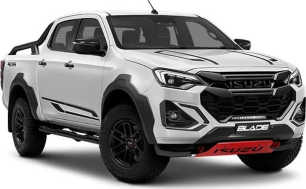The D-Max has never been a stand-out performer on-road in the ute segment, but it’s never been atrocious either.
The engine and auto combination yield a solid drivability rather than any liveliness, which works fine in this ute package.
Suffice to say, the D-Max is consistently middle of the pack when it comes to ride and handling or refinement comparisons, but again that suits this ute package.
Besides, the D-Max is a body-on-frame ute with leaf spring rear suspension, so it can’t be expected to produce sportscar-like driving qualities, though the most recent upgrades to the D-Max did improve the steering and driver-assist tech.
But then came the Blade project, which wasn’t about improving the ute’s around-town driveability: Isuzu brought in the Walkinshaw Automotive Group, one of Australia’s leading automotive engineering firms, to make a version of the D-Max that was even better at off-roading than the standard unmodified D-Max.
Boiling down thousands of kilometres and man-hours of Walkinshaw’s work on the Blade into the most salient points for this yarn does not accurately reflect the effort of those involved in the years-long process … but here goes anyway: Walkinshaw has designed, engineered and remanufactured some of Australia’s most iconic nameplates, and, while the Blade reworking doesn’t introduce any new mechanical or driver-assist tech set-ups to the D-Max package, the introduction of new all-terrain tyres, wider wheel track and Aussie-tuned suspension (including Monroe 35mm MTV twin-tube dampers with lifted spring seats) has added a welcome measure of composure to this ute’s on-road behaviour.
And Isuzu big wigs must be feeling a bit chuffed at this point in time because Walkinshaw’s off-road mods have produced real results where they count most: off-road.
The standard D-Max in LS-U+ guise is an impressive 4WD ute, but the Blade version is a touch better on a variety of terrain for a number of reasons.
For starters, the Blade’s Walkinshaw-developed suspension set-up, with those 35mm twin-tube dampers in the mix, yields a more agreeable drive, with more comfort and better chassis control than a regular D-Max on fast dirt tracks and corrugated gravel roads. It manages to subdue most of the lumps and bumps you’re bound to drive over on your way to a beach- or bush-camping destination.
The Blade’s wheel track – at 1602mm, 32mm wider than the LS-U+’s 1570mm – gives this ute a slightly more planted posture than its standard stablemate for improved stability and handling.
And while the Blade’s tyres aren’t gung-ho mud-terrains or something similar, its 275/65R17 Goodyear Wrangler Duratrac RT all-terrain tyres do work sufficiently well on-road and off.
For low-range 4WDing, the Blade has all of the D-Max good stuff – including a tractable engine with plenty of low-down torque and a recalibrated off-road traction control (part of the most recent D-Max upgrades) – but its ground clearance (244mm vs the LS-U+’s 240mm) and off-road angles (29.2° approach, 19.2° departure and 25.2° breakover vs the LS-U+’s 30.5°, 19.0°, and 23.8°) don’t represent as much of an improvement over its stablemate as you’d expect in a vehicle touted by Isuzu as “an off-road ute without compromise” and “an unparalleled combination of off-road performance and rugged reliability”.
The Blade feels vulnerable to underbody knocks from rocks and the like, but it has 3mm-thick steel bash plate protection so there’s no need to lose any sleep over a few ‘rubbing dirt’ moments.
Its tubular sidesteps at least seem hardier than the standard D-Max’s sidesteps and seem able to cop knocks from rocks without crumpling.
If there’s any need for a vehicle recovery, the Blade has eight-tonne load-rated recovery points (with bracing between chassis rails for torsional rigidity) to work with.
Also, if you’re thinking about using your Blade as a touring platform, at a listed kerb weight of 2204kg, it is 89kg heavier than the LS-U+, and its payload is 896kg (down form the LS-U+’s 990kg). GVM is 3100kg, GCM is 6000kg.
Towing capacities remain at 750kg (unbraked) and 3500kg (braked).

